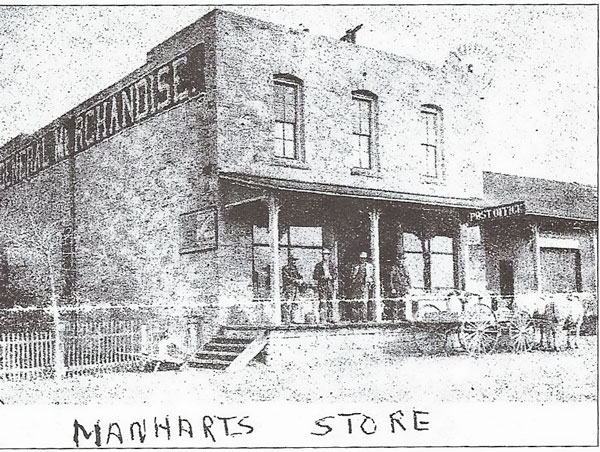Shot through the heart

By Joe Gschwendtner; photo courtesy of the Colorado Historical Society

The scene of the crime, George Manhart’s dry goods store and dance hall in Sedalia circa A 100-year pine standing today in front of Gabriel’s Restaurant marks the stairs and northwest edge of Manhart’s where Campbell met his fate.
Yes he was. Tom Campbell. Dead. Finished off with a bullet in George Manhart’s dance hall in Sedalia on Saturday, May 6, 1899 as reported in The Castle Rock Journal at the time.
Campbell, aka Thomas Jackson, was a tough customer. Well-known in Douglas County and earlier as a Denver policeman, he carried the weighty title of “street commissioner.” There, he apparently first met his would-be assassin William Hoffman and a feud between them developed. Campbell had been married but his wife deserted him, an event he blamed on Hoffman, his cousin. Those who knew Campbell well said he was the hard drinking kind who loved a good bare-knuckled fight.
Of late, Campbell had become ranch foreman for New Yorker Chester Chapin. Newspapers recorded his numerous trips east, bringing livestock by rail to New York City and Chicago. On the night of May 6th, there was no way of knowing whether Campbell had been drinking before arriving at Manhart’s. Given the bad blood between Campbell and Hoffman, it was only a matter of time before a confrontation would occur.
By 2 a.m. on that Saturday, most of Manhart’s patrons were pretty well inebriated. As those remaining patrons were being hustled out, it happened that Campbell and Hoffman met on the outside stairs from Manhart’s dance hall. John Lewis, Campbell’s brother-in-law was a shade too late to the action; from a distance he could see them squaring off.
Campbell, always the aggressor, reportedly called Hoffman a name. The defense would later secure testimony that a knife was brandished. Almost instantly, a shot rang out and a bullet from Hoffman’s gun caught Campbell full on in the chest. By the time the second bullet was fired, he had already collapsed to the floor. A local physician, Dr. MacLennan was nearby and pronounced him instantly dead, as the bullet passed through his heart.
Hoffman was not arrested until the following afternoon when the local constable, Adam Martz, apprehended him at his stepfather’s home and took him directly to the Sedalia jail. After a brief inquest confirmed that Campbell had indeed died of a gunshot wound at the hand of Hoffman, he bonded out of jail for $1,500. The local coroner did himself proud. By Sunday, the body was embalmed and taken to Denver by Campbell’s brother for burial services held at Parson Uzzeli’s Tabernacle.
Few grieved at Campbell’s death. His personality and lifestyle endeared him to no one. At home, he left a mother, brother and 14-year-old son to struggle without his income. Hoffman, on the contrary, was seen as a fine young man. Most of the wagging tongues in Sedalia were convinced that Hoffman’s shooting was well-justified. Those sympathies notwithstanding, Hoffman was convicted of manslaughter in November and sent to the penitentiary. In June 1900, George Manhart circulated a petition for mercy signed by most of the townsfolk. Months later, Hoffman was pardoned early by the governor. Back in Sedalia, the press would report “he received a cordial welcome from all he met.”